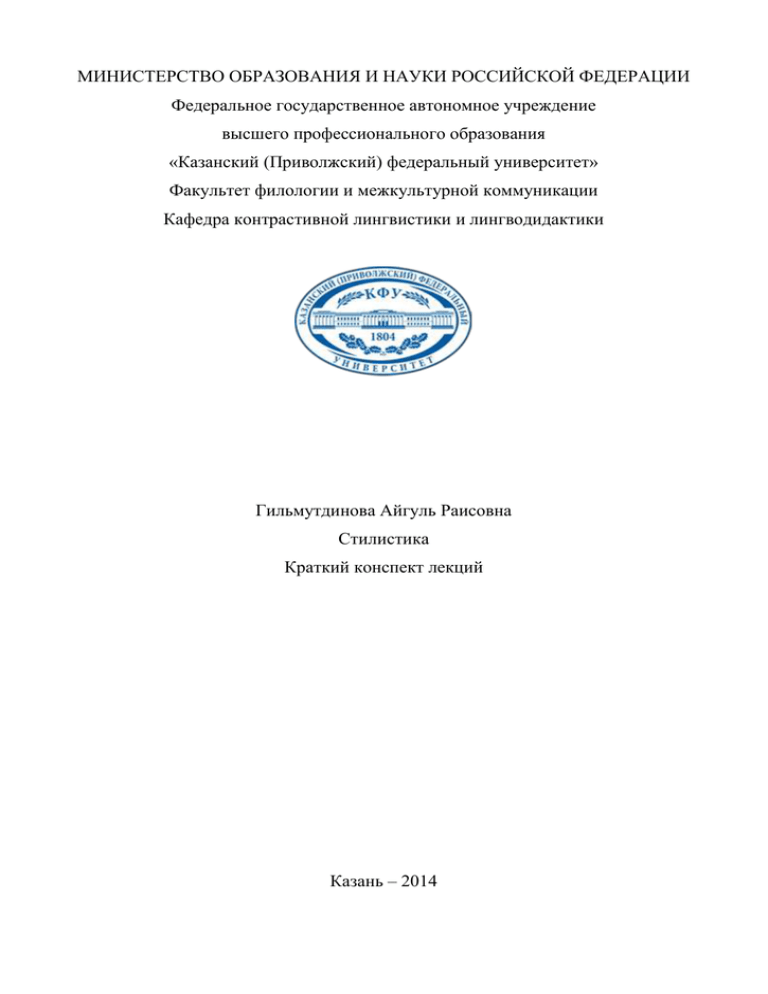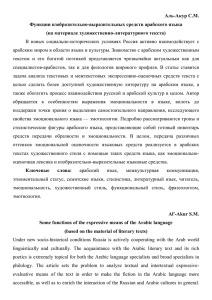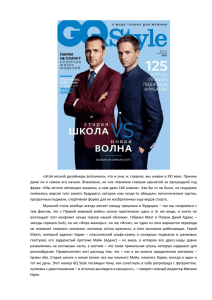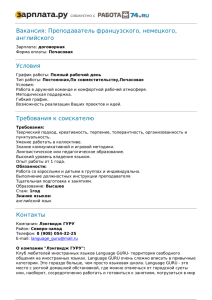Краткий конспект лекций Файл
реклама

МИНИСТЕРСТВО ОБРАЗОВАНИЯ И НАУКИ РОССИЙСКОЙ ФЕДЕРАЦИИ Федеральное государственное автономное учреждение высшего профессионального образования «Казанский (Приволжский) федеральный университет» Факультет филологии и межкультурной коммуникации Кафедра контрастивной лингвистики и лингводидактики Гильмутдинова Айгуль Раисовна Стилистика Краткий конспект лекций Казань – 2014 Направления подготовки: 050100.62 Педагогическое образование (профиль: «Иностранный язык и второй иностранный язык» на базе СПО) Учебный план "Стилистика" (В.1 http://kpfu.ru/pdf/portal/oop/26970.pdf) Дисциплина: «Стилистика» (бакалавриат, 4 курс, 7 семестр; очное обучение) Количество часов: - 108 ч. (в том числе: лекции - 18, практические занятия - 10, самостоятельная работа - 80; форма контроля - экзамен (7-й семестр). Аннотация: Данный электронный ресурс направлен на формирование теоретических знаний о языковых средствах со стороны их значения, экспрессивных возможностей и принадлежности к тому или иному функциональному стилю речи. Основными задачами дисциплины являются изучение категориального аппарата стилистики с освоением правил выделения языковых средств всех уровней с точки зрения их экспрессивности, выразительных возможностей; изложение теоретических основ стилистики, ознакомление с стилистическими свойствами фонетических, лексико- фразеологических и морфолого-синтаксических средств языка, принципами речевой организации стилей, закономерностями функционирования языковых средств в речи. Курс включает в себя материал по 9 лекциям, 5 семинарам, глоссарий с основными терминами курса, примерное тестовые задания текущего контроля, вопросы к экзамену, темы эссе и реферата. Электронный курс покрывает 40 часов самостоятельной работы (написание эссе, выполнение тестов, написание реферата). В целом, электронный курс покрывает 63% программы дисциплины. Темы: Тема 1. Предмет и задачи курса стилистики современного английского языка. Тема 2. Лексико-фразеологические выразительные средства и стилистические приемы. Тема 3. Морфологические стилистические средства. Тема 4. Синтаксические выразительные средства и стилистические приемы. Тема 5. Фонетические стилистические средства. Тема 6.Функциональные стили современного английского языка. 2 Ключевые слова: стилистика, стилистическое средство, стилистический прием, Автор функциональный курса: Гильмутдинова стиль, Айгуль выразительное Раисовна, доцент средство. кафедры контрастивной лингвистики и лингводидактики, кандидат филологических наук, E-mail: [email protected] Дата начала эксплуатации: 1 марта 2015 г. Доступность: требует обязательной регистрации обучаемых. Язык интерфейса: русский, английский 3 Оглавление Тема 1. Предмет и задачи курса стилистики 5 современного английского языка. Тема 2. Лексико-фразеологические выразительные средства и стилистические приемы. Тема 3. Морфологические стилистические средства. Тема 4. Синтаксические выразительные средства и стилистические приемы. Тема 5. Фонетические стилистические средства. Тема 6.Функциональные стили современного английского языка. Информационные источники Глоссарий Вопросы к экзамену 4 Тема 1. Предмет и задачи курса стилистики современного английского языка. Лекция 1 Аннотация: Данная тема дает основное представление о дисциплине «Стилистика», раскрывает понятие стиля, цели и задачи стилистики. Ключевые слова: style, stylistics, expressive means, descriptive stylistics, cognitive stylistics, applied stylistics, comparative stylistics, literary stylistics. Методические рекомендации по изучению темы. Вначале необходимо изучить лекционный материал с определениями основных понятий. После этого следует ответить на контрольные вопросы. Ответы нужно оформить отдельным файлом и отправить на проверку преподавателю. Затем необходимо выполнить задания по теме, основываясь на изученный теоретический материал. Студентам предлагается изучить рекомендуемую литературу, которая является вспомогательным материалом при написании эссе по Теме 1. Все возникшие вопросы можно обсудить с преподавателем и студентами на Форуме по Теме 1. Рекомендуемая литература: 1. Арнольд И.В. Стилистика современного английского языка. Л.: «Просвещение», 1981. 220с. с.7-9. 2. Гуревич В.В. Стилистика английского языка: Учеб. пособие. - М.: Флинта Наука, 2007. - 72с. с.3-9. 3. Знаменская Т.А. Стилистика английского языка. Основы курса. - М.: КомКнига, 2006. - 224с. с.9-19. 4. Ивашкин М.П. Практикум по стилистике английского языка = A Manual of English Stylistics: [учебное пособие]. М.:АСТ: Восток-Запад, 2005. с.46. 5 5. Кокшарова Н.Ф. Лекции по стилистике (английский язык): учебное пособие/ Н.Ф. Кокшарова; Томский политехнический университет. – Томск: Изд-во Томского политехнического университета, 2011 – 104 с. с.4-8. 6. Кухаренко В.А. Практикум по стилистике английского языка. М.: Высшая школа, 1986. с.3-5. 7. Baldick, Ch. Oxford Concise Dictionary of Literary Terms. Oxford University Press, 1996. 8. Galperin I.R. Stylistics. M.: «Высшая школа», 1981. 335 с.с.9-25. 9. Skrebnev Y.M. Fundamentals of English Stylistics. M.1994. с.4-10. Интернет-ресурсы 1. Гальперин А.И. "Очерки по стилистике английского языка". http://www.classes.ru/grammar/30.Ocherki_po_stilistike_angliyskogo_yazyka/ht ml/unnamed.html 2. http://encyclopedia2.thefreedictionary.com/ 3. http://www.ego4u.com/ 4. http://enc-dic.com/lit 5. http://literarydevices.net/ Глоссарий applied stylistics - a type of stylistics that focuses on the study of contextually different varieties of language especially with reference to the style of literary and non-literary texts. cognitive stylistics - a type of stylistics that investigates the way we transfer mental constructs, especially the way we map one mental representation onto another when we read texts. communicative stylistics - a type of stylistics that describes expressive peculiarities of certain messages (texts). 6 comparative stylistics – a type of stylistics that analyses the stylistic resources not inherent in a separate language but at the crossroads of two languages. device - a literary contrivance used to achieve a particular effect. figure of speech - a stylistic device, including tropes and syntactical expressive means used to intensify the emotional expressiveness of an utterance. imagery- a figurative or descriptive language in a literary work. literary stylistics – a type of stylistics that investigates distinctive features of different literary trends and genres, individual styles of different authors and extralinguistic factors stylistics - the branch of linguistics that studies the style of language and describes the norms and usage of literary language in speech, in various types of written works, and in public affairs. stylistics of resources – a type of stylistics that studies stylistically coloured language means, expressive abilities and semantic nuances of words, forms and constructions. style - a variant of a language used in such social situations as everyday and family life or in official and commercial affairs, and differing from other variants of the same language in lexicon, grammar, and phonetics. Вопросы для изучения 1. The term ‘style’. 2. Style study. The aims and tasks of stylistics. 3. Types of stylistics. The term ‘style’. There is confusion between the terms "style" and "stylistics". The first concept is so broad that it is hardly possible to regard it as a term. We speak of style in architecture, literature, behaviour, linguistics, dress and other fields of human activity. 7 Definitions of style are conditioned by the concepts of language and of linguistic norms. When the standard spoken language is accepted as the linguistic norm, style is defined as a variant of this language, and colloquial language as well is regarded as a style. However, when the norm has the more restricted meaning of correct literary speech, style is defined as a variant of the literary language. Classification of style varies accordingly. There is a widely held view that style is the correspondence between thought and expression. A very popular notion among practical linguists, teachers of language, is that style is technique of expression. Another commonly accepted connotation of the term style is embellishment of language. The term "style" also signifies a literary genre. Thus we speak of classical style or the style of classicism; realistic style. Style study. The aims and tasks of stylistics. Style Study is a branch of general linguistics which investigates the principles and the effect of the choice and usage of various language means (lexical, grammatical, phonetic) to convey thoughts and emotions in different communication conditions Stylistics deals with language in the broad sense of the term, which includes speech, but stylistics differs from other areas of linguistics in that it is concerned with language and society and with sociolinguistics. Stylistics studies the means of expressing the supplementary (stylistic) information that accompanies the content of speech. A related subject of study is the system of a language’s synonymic means and potentialities at all levels. Stylistics also studies the linguistic norms of past periods of language development. Historical stylistics deals with these topics and also seeks to identify shifts and nuances in style, although its primary aim is to trace the history of stylistic systems, the origin, formation, and development of stylistic variants within languages, and the history of the interactions among these variants. Thus the subject matter of Style Study is emotional expression of the language, the totality of the expressive means. The main aims of Stylistics are: 8 1) to analyze the choice of a definite language means in a row of synonymous forms expressing the thought to convey the information most fully and effectively; 2) to analyze different expressive means in the language hierarchy; 3) to define the stylistic function performed by any linguistic means. Types of stylistics. The divisions in stylistics are the following: 1. Stylistics of resources is a descriptive stylistics. It studies stylistically coloured language means, expressive abilities and semantic nuances of words, forms and constructions. 2. Comparative stylistics analyses the stylistic resources not inherent in a separate language but at the crossroads of two languages, or two literatures and is obviously linked to the theory of translation. 3. Literary stylistics investigates distinctive features of different literary trends and genres, individual styles of different authors and extra-linguistic factors, which help to shape them, literary norms of a given period, as well as stylistic and aesthetic evaluation of the works of men of letters (writers). 4. Linguo-stylistics compares National Language Standard or Norm with particular, typical to different spheres of communication subsystems (called functional styles) and dialects and studies language means with relation to their ability to express and evoke different feelings, additional associations and evaluation. The language means may be studied at different levels: vocabulary, grammar and phonetics, thus distinguishing lexical, grammatical and phonetic stylistics. 5. Applied stylistics focuses on the study of contextually different varieties of language especially with reference to the style of literary and non-literary texts. 6. Cognitive stylistics investigates the way we transfer mental constructs, especially the way we map one mental representation onto another when we read texts – conceptual transfer. 9 7. Communicative stylistics describes expressive peculiarities of certain messages (texts); enables the scholar to interpret a work of art with a minimum loss of its purport and message. Контрольные вопросы по теме 1. 1. What are the definitions of ‘style’? 2. What is the norm of the language? 3. What is stylistics? 4. What are the aim and tasks of stylistics? 5. What styles of language do we distinguish? 6. What types of stylistics can you name? What do they study? 10



